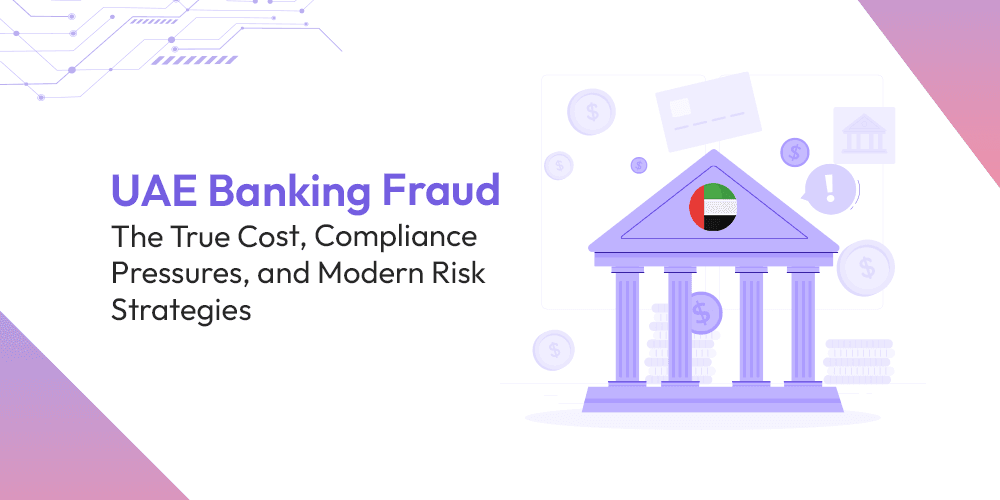
UAE Banking Fraud: The True Cost, Compliance Pressures, and Modern Risk Strategies
RaptorX.ai
Sunday, May 18, 2025
The UAE’s banking sector stands at a pivotal intersection of technological progress and mounting financial risk. Renowned for its rapid digitization and commitment to real-time service delivery, it now finds itself increasingly vulnerable to a more agile and networked adversary: financial fraud.
As digital channels grow in speed and complexity, fraudsters have matched that pace—leveraging automation, social engineering, and synthetic identities to exploit systemic blind spots. The direct financial damage is clear, but what remains underappreciated are the hidden costs: diverted resources, compliance strain, operational inefficiencies, and, perhaps most critically, the erosion of customer trust.
Understanding the Full Cost of Fraud
Between 2021 and 2023, the UAE banking sector reported fraud-related financial losses amounting to $338 million. In 2023 alone, Authorised Push Payment (APP) scams jumped 43%, reaching $8.3 million in losses. But beyond these figures lies a more corrosive reality: the operational drag created by fraud mitigation efforts.
For every dollar lost to fraud, institutions spend an average of $4.19 on related activities—detection, investigation, remediation. This includes:
- High manual review workloads
- Excessive false positives requiring analyst attention
- Resource reallocation from strategic initiatives to firefighting
This cycle is not only inefficient—it’s unsustainable.
Rising Compliance Pressure
2023 was also a watershed year for regulatory enforcement in the UAE. Financial institutions faced:
- $69 million in AML-related fines
- $639 million in seized illicit assets
Regulators are now expecting institutions to do more than monitor—they must act swiftly, explain thoroughly, and document everything.
This creates two fundamental compliance challenges:
- Responsiveness – Institutions must detect and report suspicious activity in real-time, especially as instant payments become the norm.
- Defensibility – Systems must provide transparent audit trails and be able to justify decisions during regulatory reviews.
Legacy systems often fall short, relying on siloed data and reactive controls ill-equipped for today’s dynamic risk landscape.
Why Traditional Fraud Models Fail
Fraud is no longer isolated or transactional. It exists in webs—spanning multiple accounts, devices, wallets, beneficiaries, and payment paths. Yet many institutions continue to rely on outdated methods that treat fraud as a rule violation, not a network phenomenon.
Three critical limitations are commonly observed:
- Rules-Based Fragility – Hard-coded thresholds are rigid and easily circumvented by adaptive adversaries.
- History-Dependent Detection – Models that rely on past fraud patterns are ineffective against novel, first-time attacks.
- Slow Manual Reviews – By the time fraud is confirmed, the funds are typically unrecoverable.
Worse, overly sensitive systems often mistake legitimate customer behavior for risk, damaging user experience and retention.
The Shift to Network-Centric, Real-Time Intelligence
Leading institutions are rethinking fraud and compliance—not as separate domains, but as integrated disciplines powered by shared intelligence and real-time analytics. This shift requires three strategic pivots:
1. Network Intelligence
Fraud is better detected by analyzing the relationships between entities rather than isolated events. A flagged beneficiary connected to multiple risky accounts, or a device accessing diverse high-risk wallets, may signal fraud before the transaction even completes.
2. Real-Time Detection
Delays in detection equal increased loss. Sub-second analysis is no longer optional—it is mandatory, especially in an ecosystem dominated by instant payments.
3. Adaptive Learning
Rigid, pre-defined rules must give way to systems that evolve with fraud behavior. Techniques like anomaly detection, graph analytics, and unsupervised learning are enabling banks to identify novel fraud patterns without relying solely on past data.
Tangible Gains from Modernization
Banks implementing network-first, adaptive strategies are seeing measurable outcomes:
- 40–60% reduction in false positives
- Investigation times cut by up to 80%
- Hundreds of analyst hours reclaimed monthly
- Fraud loss avoidance ranging from $10M to $100M annually
These are not theoretical improvements. They represent the difference between a reactive institution and one capable of proactive interdiction—before damage occurs.
Convergence of Fraud and Compliance
What’s becoming increasingly clear is that fraud prevention and AML are converging. Institutions are gaining efficiency and accuracy by:
- Unifying fraud and AML alerting pipelines
- Linking account, transaction, device, and location data
- Mapping time-based behavioral patterns across channels
By treating fraud and compliance as extensions of the same risk spectrum, banks can reduce duplication, eliminate silos, and strengthen both outcomes and oversight.
Conclusion: A Strategic Imperative, Not a Technical Choice
The cost of fraud is no longer just monetary. It touches every part of a financial institution’s ecosystem—from customer trust to compliance readiness to innovation capacity. In today’s hyper-connected world, old models aren’t just inadequate—they’re a liability.
At RaptorX we’ve seen that success doesn’t stem from a single tool or quick fix, but from a strategic commitment to building systems that are relationship-aware, real-time, and regulator-ready.
Modern fraud requires modern defense. The institutions that recognize this are not just mitigating risk—they’re redefining resilience.

